Evaluations of Remote Sensing-Based Global Evapotranspiration Datasets at Catchment Scale in Mountain Regions
Abstract
:1. Introduction
2. Materials and Methods
2.1. Study Area
2.2. Data
2.2.1. Observed Data
2.2.2. RS_ET Datasets
2.3. Methods
2.3.1. Cumulative Distribution Function (CDF)-Biased WB Method
2.3.2. Generalized CR (H2018) Method
2.3.3. Evaluation Criteria
2.3.4. The Method of Trends Detection
3. Results
3.1. Evaluation of RS_ET Datasets against Water Balance Estimates
3.2. Evaluation of CR Series against Water Balance Estimates
3.3. Spatial and Temporal Variation of ET at Multiple Spatial Scales
4. Discussion
5. Conclusions
- (1)
- The RS_ET datasets accurately simulated ET at the monthly scale in the HDM region, with mean cc and NSE values of 0.89 and 0.68, respectively. The SSEBop outperformed the others, with NSE and KGE values of 0.80 and 0.90, respectively. This was followed by GLASS and BESS. The NTSG and MOD16 performed worse, with mean RE values of more than 10.0% and mean NSE values below 0.50. In addition, the RS_ET datasets showed high accuracy in estimating the mean values in both the semiarid and humid regions. RT_ES showed relatively better performance in simulating monthly time series in semiarid regions than in humid regions, with the mean NSE value of the former being 0.78.
- (2)
- The CR model was also able to accurately simulate ET at the monthly scale in the HDM region, with mean cc, NSE, and RMSE values of 0.90, 0.81, and 9.07 mm mon−1, respectively. The simulation results of CR_ET in the wet season were better than those in the dry season, with cc and NSE values of 0.91 and 0.76, respectively. Moreover, the comprehensive performance of CR_ET in the Lancang River Basin was better, with mean cc and NSE of 0.92 and 0.83, respectively.
- (3)
- The spatial and temporal variations of the ET time series, including WB_ET, CR_ET, and RS_ET, were generally consistent in the HDM region. All ET time series showed a significant decreasing trend in the northern semiarid region of the HDM, with the lowest mean annual ET. Meanwhile, they exhibited an increasing trend in the humid southern region, with the highest mean annual ET.
Author Contributions
Funding
Institutional Review Board Statement
Informed Consent Statement
Data Availability Statement
Acknowledgments
Conflicts of Interest
References
- Oki, T.; Kanae, S. Global hydrological cycles and world water resources. Science 2006, 313, 1068–1072. [Google Scholar] [CrossRef] [Green Version]
- Trenberth, K.E.; Fasullo, J.T.; Kiehl, J. Earth’s global energy budget. Bull. Am. Meteorol. Soc. 2009, 90, 311–323. [Google Scholar] [CrossRef]
- Katul, G.G.; Oren, R.; Manzoni, S.; Higgins, C.; Parlange, M.B. Evapotranspiration: A process driving mass transport and energy exchange in the soil-plant-atmosphere-climate system. Rev. Geophys. 2012, 50, RG3002. [Google Scholar] [CrossRef] [Green Version]
- Miralles, D.G.; Jiménez, C.; Jung, M.; Michel, D.; Ershadi, A.; McCabe, M.F.; Hirschi, M.; Martens, B.; Dolman, A.J.; Fisher, J.B. The WACMOS-ET project-Part 2: Evaluation of global terrestrial evaporation data sets. Hydrol. Earth Syst. Sci. 2020, 20, 823–842. [Google Scholar] [CrossRef] [Green Version]
- Ryu, Y.; Baldocchi, D.D.; Kobayashi, H.; Van Ingen, C.; Li, J.; Black, T.A.; Beringer, J.; van Gorsel, E.; Knohl, A.; Law, B.E. Integration of MODIS land and atmosphere datasets with a coupled-process model to estimate gross primary data setsivity and evapotranspiration from 1 km to global scales. Global Biogeochem. Cycles. 2011, 25, GB4017. [Google Scholar] [CrossRef] [Green Version]
- Zhang, Y.Q. PML_V2 global evapotranspiration and gross primary data setsion (2002.07–2019.08). Natl. Tibet. Plateau Data Center 2020, 56, e2020WR028205. [Google Scholar] [CrossRef]
- Senay, G.B.; Bohms, S.; Singh, R.K.; Gowda, P.H.; Velpuri, N.M.; Alemu, H.; Verdin, J.P. Operational Evapotranspiration Mapping Using Remote Sensing and Weather Datasets: A New Parameterization for the SSEB Approach. J. Am. Water Resour. Assoc. 2013, 49, 577–591. [Google Scholar] [CrossRef] [Green Version]
- Panahi, M.D.; Tabas, S.S.; Kalantari, Z.; Ferreira, C.S.S.; Zahabiyoun, B. Spatio-temporal assessment of global gridded evapotranspiration datasets across Iran. Remote Sens. 2021, 13, 1816. [Google Scholar] [CrossRef]
- Liu, Z.F. The accuracy of temporal upscaling of instantaneous evapotranspiration to daily values with seven upscaling methods. Hydrol. Earth Syst. Sci. 2021, 25, 4417–4433. [Google Scholar] [CrossRef]
- Imeshi, W.; Wim, B.; Marloes, M.; Jia, L.; van Ann, G. Can we trust remote sensing evapotranspiration products over Africa? Hydrol. Earth Syst. Sci. 2020, 24, 1565–1586. [Google Scholar] [CrossRef] [Green Version]
- Koppa, A.; Alam, S.; Miralles, D.G.; Gebremichael, M. Budyko-based long-term water and energy balance closure in global watersheds from Earth observations. Water Resour. Res. 2021, 57, e2020WR028658. [Google Scholar] [CrossRef] [PubMed]
- Luo, Z.; Shao, Q.; Wan, W.; Li, H.; Chen, X.; Zhu, S.; Ding, X. A new method for assessing satellite-based hydrological data products using water budget closure. J. Hydrol. 2021, 594, 125927. [Google Scholar] [CrossRef]
- Schoups, G.; Nasseri, M. GRACEfully closing the water balance: A data-driven probabilistic approach applied to river basins in Iran. Water Resour. Res. 2021, 57, e2020WR029071. [Google Scholar] [CrossRef]
- Bai, P.; Liu, X.M. Intercomparison and evaluation of three global high-resolution evapotranspiration data sets across China. J. Hydrol. 2018, 566, 743–755. [Google Scholar] [CrossRef]
- Baik, J.; Umar, W.L.; Minha, C. Assessment of satellite- and reanalysis-based evapotranspiration productswith two blending approaches over the complex landscapes and climates of Australia. Agric. For. Meteorol. 2018, 263, 388–398. [Google Scholar] [CrossRef]
- Sorensson, A.A.; Ruscica, R.C. Intercomparison and uncertainty assessment of nine evapotranspiration estimates over South America. Water Resour. Res. 2018, 54, 2891–2908. [Google Scholar] [CrossRef] [Green Version]
- Xu, T.R.; Guo, Z.X.; Xia, Y.L.; Vagner, G.F.; Liu, S.M.; Wang, K.C.; Yao, Y.J.; Zhang, X.J.; Zhao, C.S. Evaluation of twelve evapotranspiration data sets from machine learning. J. Hydrol. 2019, 578, 124105. [Google Scholar] [CrossRef]
- Wu, J.; Venkataraman, L.; Wang, D.S.; Lin, P.R.; Pan, M.; Cai, X.T.; Wood, E.F.; Zeng, Z.Z. The Reliability of Global RS Evapotranspiration Data sets over Amazon. Remote Sens. 2020, 12, 2211. [Google Scholar] [CrossRef]
- Zhang, K.; Kimball, J.S.; Nemani, R.R.; Running, S.W. A continuous satellite-derived global record of land surface evapotranspiration from 1983 to 2006. Water Resour. Res. 2010, 46, W09522. [Google Scholar] [CrossRef] [Green Version]
- Zhang, K.; Kimball, J.S.; Nemani, R.R.; Running, S.W.; Hong, Y.; Gourley, J.J.; Yu, Z.B. Vegetation greening and climate change promote multidecadal rises of global land evapotranspiration. Sci. Rep. 2015, 5, 15956. [Google Scholar] [CrossRef]
- Mu, Q.; Heinsch, F.A.; Zhao, M.; Running, S.W. Development of a global evapotranspiration algorithm based on MODIS and global meteorology data. Remote Sens. Environ. 2007, 111, 519–536. [Google Scholar] [CrossRef]
- Mu, Q.; Heinsch, F.A.; Zhao, M.; Running, S.W. Improvements to a MODIS global terrestrial evapotranspiration algorithm. Remote Sens. Environ. 2011, 115, 1781–1800. [Google Scholar] [CrossRef]
- Chen, X.L. Surface energy balance based global land evapotranspiration (EB-ET 2000–2017). Natl. Tibet. Plateau Data Center 2018. [Google Scholar] [CrossRef] [Green Version]
- Martens, B.; Miralles, D.G.; Lievens, H.; Van Der Schalie, R.; De Jeu, R.A.M.; Fernández-Prieto, D.; Beck, H.E.; Dorigo, W.A.; Verhoest, N.E.C. GLEAM v3: Satellite-based land evaporation and root-zone soil moisture. Geosci. Model Dev. 2017, 10, 1903–1925. [Google Scholar] [CrossRef] [Green Version]
- Miralles, D.G.; Holmes, T.R.H.; De Jeu, R.A.M.; Gash, J.H.; Meesters, A.G.C.A.; Dolman, A.J. Hydrology and Earth System Sciences Global land-surface evaporation estimated from satellite-based observations. Hydrol. Earth Syst. Sci. 2011, 15, 453–469. [Google Scholar] [CrossRef] [Green Version]
- Yao, Y.J.; Liang, S.L.; Cheng, J.; Liu, S.; Fisher, J.B.; Zhang, X.T.; Jia, K. MODIS-driven estimation of terrestrial latent heat flux in China based on a modified Priestley-Taylor algorithm. Agric. For. Meteorol. 2013, 171, 187–202. [Google Scholar] [CrossRef]
- Yao, Y.J.; Liang, S.L.; Li, X.L.; Hong, Y.; Fisher, J.B.; Zhang, N.N.; Chen, J.Q.; Cheng, J.; Zhao, S.H.; Zhang, X.T. Bayesian multimodel estimation of global terrestrial latent heat flux from eddy covariance, meteorological, and satellite observations. J. Geophys. Res. Atmos. 2014, 119, 4521–4545. [Google Scholar] [CrossRef]
- Liang, S.; Cheng, C.; Jia, K.; Jiang, B.; Liu, Q.; Xiao, Z.; Yao, Y.; Yuan, W.; Zhang, X.; Zhao, X.; et al. The Global LAnd Surface Satellite (GLASS) products suite. Bull. Am. Meteorol. Soc. 2021, 102, E323–E337. [Google Scholar] [CrossRef]
- Liu, Z.F.; Yao, Z.J.; Wang, R. Simulation and evaluation of actual evapotranspiration based on inverse hydrological modeling at a basin scale. Catena 2019, 180, 160–168. [Google Scholar] [CrossRef]
- Wan, Z.M.; Zhang, K.; Xue, X.W.; Hong, Z.; Hong, Y.; Gourley, J.J. Water balance based actual evapotranspiration reconstruction from ground and satellite observations over the Conterminous United States. Water Resour. Res. 2015, 51, 6485–6499. [Google Scholar] [CrossRef]
- Hobbins, M.; Ramirez, J.; Brown, T.; Claessens, L. The complementary relationship in estimation of regional evapotranspiration: The complementary relationship areal evapotranspiration and advection-aridity models. Water Resour. Res. 2001, 37, 1367–1387. [Google Scholar] [CrossRef] [Green Version]
- Zhang, Y.Q.; Leuning, R.; Chiew, F.H.S.; Wang, E.L.; Zhang, L.; Liu, C.M.; Sun, F.B.; Peel, M.C.; Shen, Y.J.; Jung, M. Decadal trends in evaporation from global energy and water balances. J. Hydrometeorol. 2012, 13, 379–391. [Google Scholar] [CrossRef]
- Liu, X.M.; Liu, C.M.; Brutsaert, W. Regional evaporation estimates in the eastern monsoon region of China: Assessment of a nonlinear formulation of the complementary principle. Water. Resour. Res. 2016, 52, 9511–9521. [Google Scholar] [CrossRef]
- Han, S.J.; Tian, F.Q. Derivation of a sigmoid generalized complementary function for evaporation with physical constraints. Water Resour. Res. 2018, 54, 5050–5068. [Google Scholar] [CrossRef]
- Kahler, D.M.; Brutsaert, W. Complementary relationship between daily evaporation in the environment and pan evaporation. Water Resour. Res. 2006, 42, W05413. [Google Scholar] [CrossRef]
- Szilagyi, J. On the inherent asymmetric nature of the complementary relationship of evaporation. Geophys. Res. Lett. 2007, 34, L02405. [Google Scholar] [CrossRef] [Green Version]
- Szilagyi, J. Complementary-relationship-based 30 year normals (1981–2010) of monthly latent heat fluxes across the contiguous United States. Water Resour. Res. 2015, 51, 9367–9377. [Google Scholar] [CrossRef] [Green Version]
- Penman, H. Natural evaporation from open water, bare soil and grass. Proc. R. Soc. Lond. A. Math. Phys. Sci. 1948, 193, 120–145. [Google Scholar]
- Allen, R.G. Using the FAO-56 dual crop coefficient method over an irrigated region as part of an evapotranspiration intercomparison study. J. Hydrol. 2000, 229, 27–41. [Google Scholar] [CrossRef]
- Pearson, K. Mathematical Contributions to the Theory of Evolution-On a Form of Spurious Correlation Which May Arise When Indices Are Used in the Measurement of Organs. Lond. R. Soc. Lond. Proc. 1896, 60, 489–498. [Google Scholar]
- Nash, J.E.; Sutcliffe, J.V. River flow forecasting through conceptual models part I-A discussion of principles. J. Hydrol. 1970, 10, 282–290. [Google Scholar] [CrossRef]
- Gupta, H.V.; Kling, H.; Yilmaz, K.K.; Martinez, G.F. Decomposition of the mean squared error and NSE performance criteria: Implications for improving hydrological modelling. J. Hydrol. 2009, 377, 80–91. [Google Scholar] [CrossRef] [Green Version]
- Taylor, K.E. Summarizing multiple aspects of model performance in a single diagram. J. Geophys. Res. Atmos. 2001, 106, 7183–7192. [Google Scholar] [CrossRef]
- Hirsch, R.M.; Slack, J.R.; Smith, R.A. Techniques of trend analysis for monthly water quality data. Water Resour. Res. 1982, 18, 107–121. [Google Scholar] [CrossRef] [Green Version]
- Fu, G.B.; Charles, S.P.; Liu, C.M.; Yu, J.J. Decadal climatic variability, trends and future scenarios for the North China Plain. J. Clim. 2009, 22, 2111–2123. [Google Scholar] [CrossRef]
- Xu, Z.X.; Liu, Z.F.; Fu, G.B.; Chen, Y.N. Hydro-climate trends of the Tarim River basin for the last 50 years. J. Arid. Environ. 2010, 74, 256–267. [Google Scholar] [CrossRef]
- Wang, L.M.; Tian, F.Q.; Han, S.J.; Wei, Z.W. Determinants of the asymmetric parameter in the generalized complementary principle of evaporation. Water Resour. Res. 2020, 56, e2019WR026570. [Google Scholar] [CrossRef]
- Elnashar, A.; Wang, L.J.; Wu, B.F.; Zhu, W.W.; Zeng, H.W. Synthesis of global actual evapotranspiration from 1982 to 2019. Earth Syst. Sci. Data. 2021, 13, 447–480. [Google Scholar] [CrossRef]
- Kim, H.W.; Hwang, K.; Mu, Q.; Seung, O.; Lee, S.O. Validation of MODIS 16 Global Terrestrial Evapotranspiration Products in Various Climates and Land Cover Types in Asia. J. Civi. Eng. 2012, 16, 229–238. [Google Scholar] [CrossRef]
- Yin, L.C.; Wang, X.F.; Feng, X.M.; Fu, B.J.; Chen, Y.Z. A Comparison of SSEBoPModel-Based Evapotranspiration with Eight Evapotranspiration Data sets in the Yellow River Basin, China. Remote Sens. 2020, 12, 2528. [Google Scholar] [CrossRef]
- Liu, W.B.; Wang, L.; Zhou, J.; Li, Y.Z.; Sun, F.B.; Fu, G.B.; Li, X.P.; Sang, Y.F. A worldwide evaluation of basin-scale evapotranspiration estimates against the water balance method. J. Hydrol. 2016, 538, 82–95. [Google Scholar] [CrossRef] [Green Version]
- Gan, R.; Zhang, Y.Q.; Shi, H.; Yang, Y.T.; Eamus, D.; Cheng, L.; Chiew, F.H.S. Use of satellite leaf area index estimating evapotranspiration and gross assimilation for Australian ecosystems. Ecohydrology 2018, 11, e1974. [Google Scholar] [CrossRef]
- Khan, M.S.; Baik, J.; Choi, M. Inter-comparison of evapotranspiration datasets over heterogeneous landscapes across Australia. Adv. Space. Res. 2020, 66, 533–545. [Google Scholar] [CrossRef]
- Baker, J.C.A.; Garcia-Carreras, L.; Gloor, M.; Marsham, J.H.; Buermann, W.; da Rocha, H.R.; Nobre, A.D.; de Araujo, A.C.; Spracklen, D.V. Evapotranspiration in the Amazon: Spatial patterns, seasonality, and recent trends in observations, reanalysis, and climate models. Hydrol. Earth Syst. Sci. 2021, 25, 2279–2300. [Google Scholar] [CrossRef]
- Senay, G.B.; Friedrichs, M.; Singh, R.K.; Velpuri, N.M. Evaluating Landsat 8 evapotranspiration for water use mapping in the Colorado River Basin. Remote Sens. Environ. 2016, 185, 171–185. [Google Scholar] [CrossRef] [Green Version]
- Fisher, J.B.; Lee, B.; Purdy, A.J.; Halverson, G.H.; Dohlen, M.B.; Cawse-Nicholson, K.; Wang, A.; Anderson, R.G. ECOSTRESS: NASA’s Next Generation Mission to Measure Evapotranspiration from the International Space Station. Water Resour. Res. 2020, 56, 4. [Google Scholar] [CrossRef]
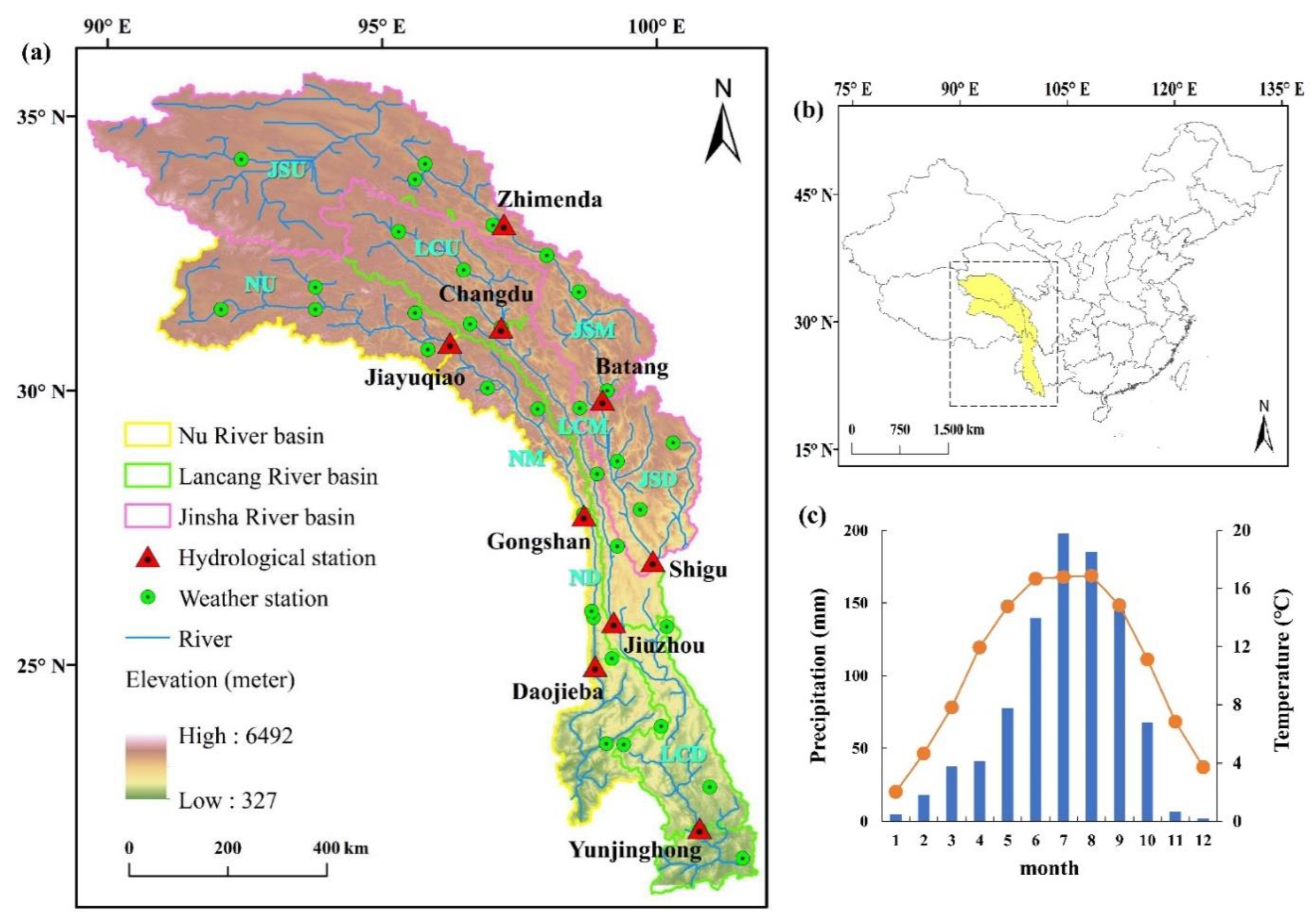
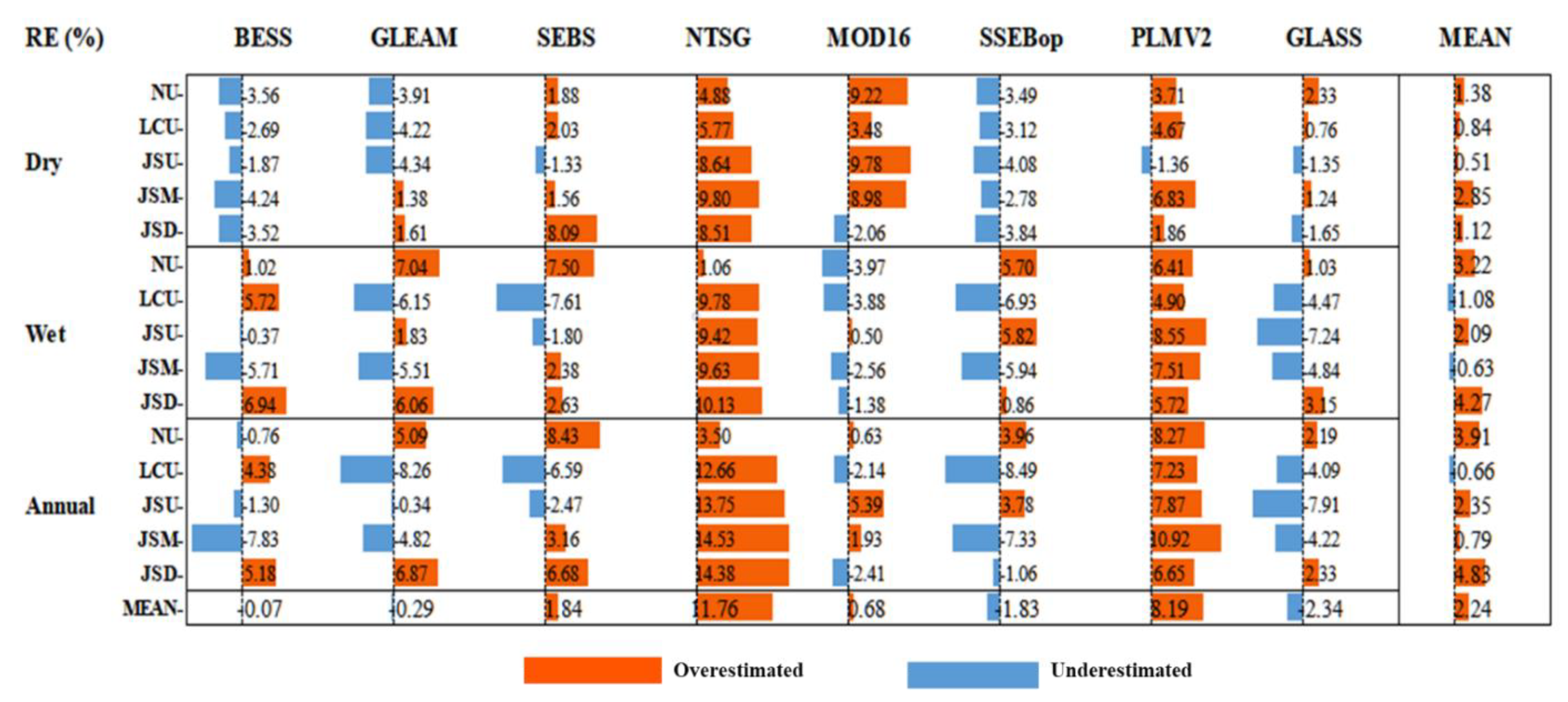
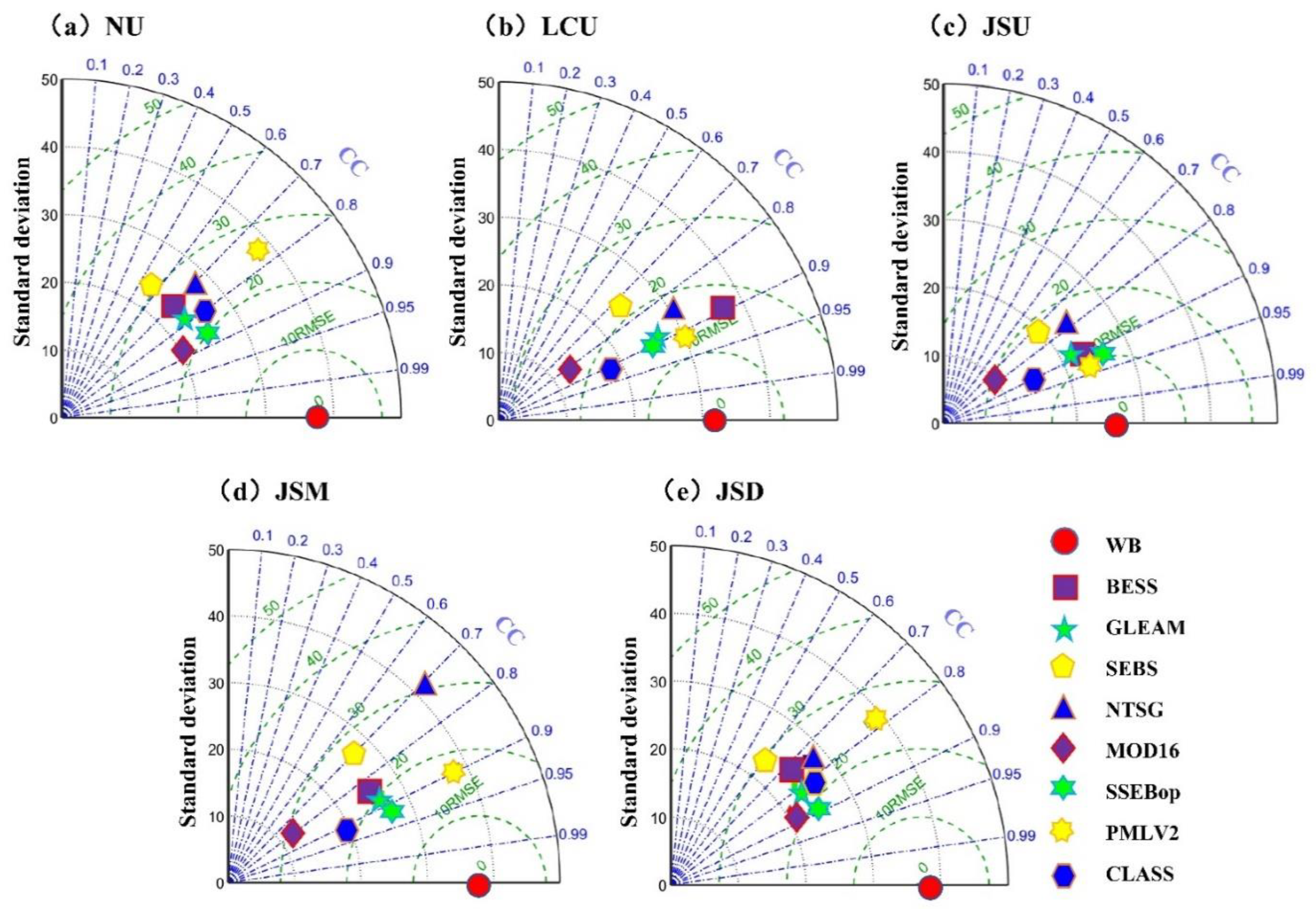


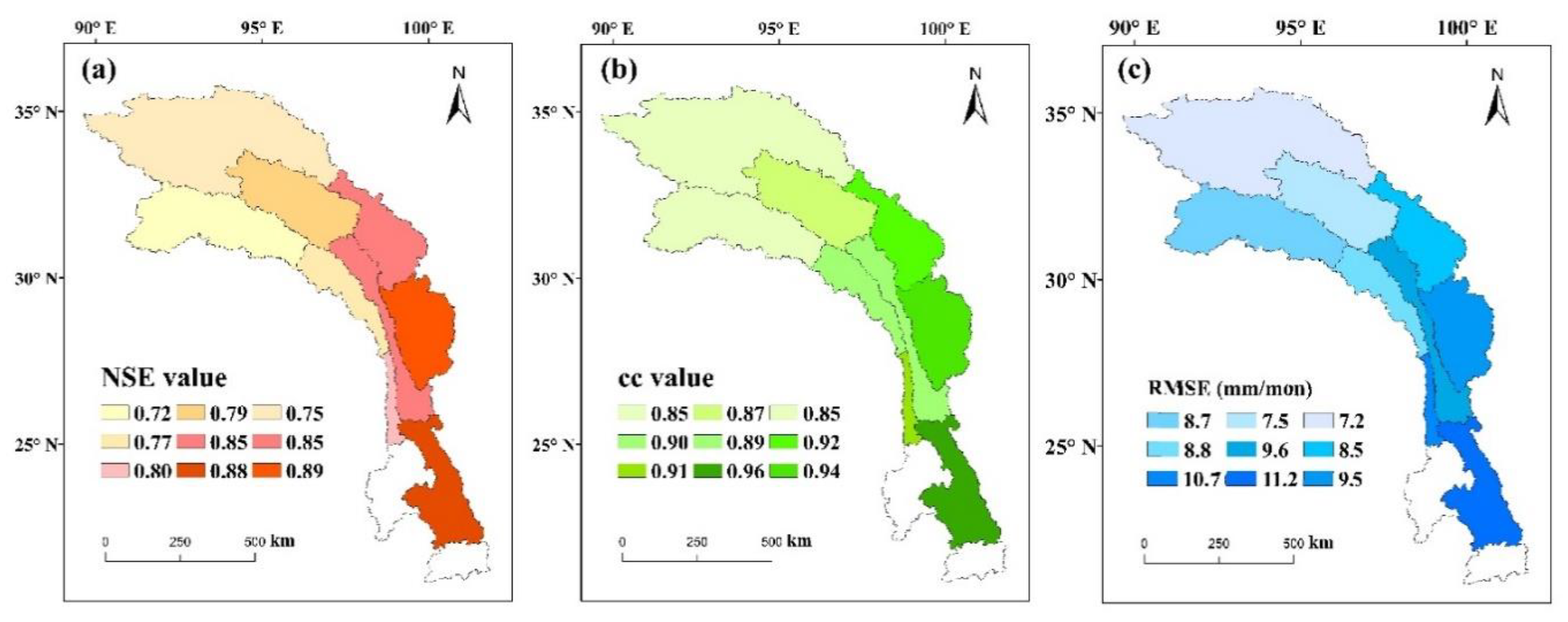
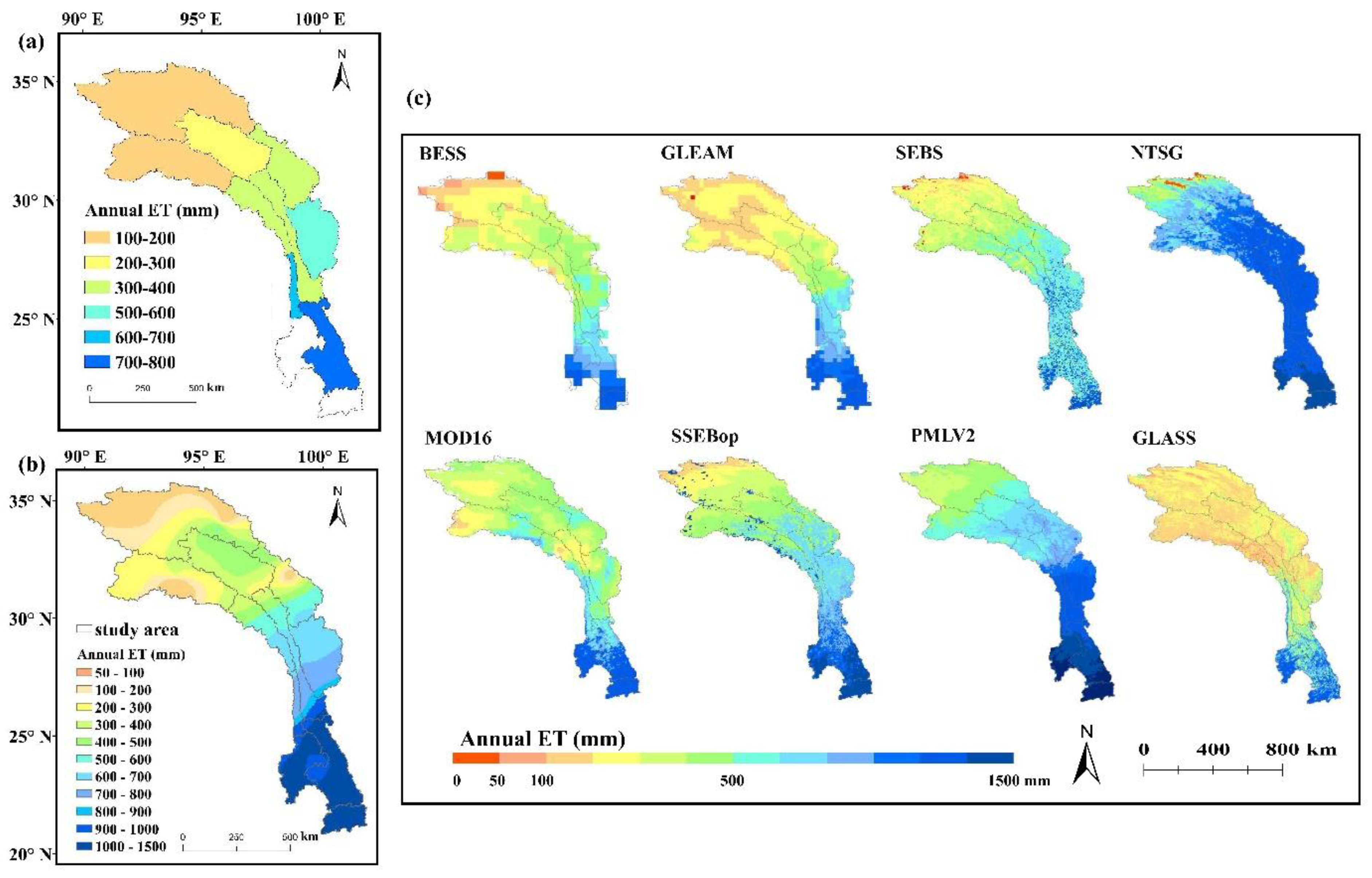

| Hydrological Station | Longitude | Latitude | Catchment | Temporal | |
|---|---|---|---|---|---|
| Area (km2) | Coverage | ||||
| Nu River Basin | Jiayuqiao | 96.24 | 30.87 | 68,384 | 1956–2000, 2007–2018 |
| Gongshan | 98.68 | 27.73 | 101,146 | 1956–2000 | |
| Daojieba | 98.88 | 24.98 | 110,224 | 1956–2000 | |
| Lancang River Basin | Changdu | 97.17 | 31.15 | 53,800 | 1956–2000, 2007–2018 |
| Jiuzhou | 99.22 | 25.79 | 88,051 | 1956–2000 | |
| Yunjinghong | 100.78 | 22.03 | 115,894 | 1956–2000 | |
| Jinsha River Basin | Zhimenda | 97.22 | 33.03 | 137,704 | 1956–1987, 2007–2018 |
| Batang | 99.02 | 29.83 | 187,873 | 1956–1987, 2007–2018 | |
| Shigu | 99.93 | 26.9 | 214,184 | 1956–1987, 2007–2018 |
| Datasets | Method | Resolution | Temporal Coverage | |
|---|---|---|---|---|
| Spatial | Temporal | |||
| BESS 1 | PM equation | 0.50° | 8 days | 2001–2015 |
| ftp://147.46.64.183 (accessed on 15 September 2020) | ||||
| GLEAM 3.5a | PT equation | 0.25° | 1 month | 1980–2020 |
| https://www.gleam.eu/ (accessed on 20 July 2021) | ||||
| SEBS 2 | Surface energy balance | 0.05° | 1 month | 2000–2017 |
| https://data.tpdc.ac.cn/zh-hans/data/5a0d2e28-ebc6-4ea4-8ce4-a7f2897c8ee6/?q=%E8%92%B8%E6%95%A3 (accessed on 10 August 2020) | ||||
| NTSG | Modified PM, PT equations | 0.083° | 1 month | 1982–2013 |
| https://www.ntsg.umt.edu/project/global-et.php (accessed on 20 July 2021) | ||||
| MOD16 | PM equation | 0.05° | 1 month | 2000–2014 |
| http://files.ntsg.umt.edu/data/NTSG_Products/MOD16/MOD16A2_MONTHLY.MERRA_GMAO_1kmALB/GEOTIFF_0.05degree/ (accessed on 5 August 2020) | ||||
| SSEBop 3 | Simplified surface energy balance | 0.096° | 1 month | 2003–2020 |
| https://earlywarning.usgs.gov/fews/search (accessed on 1 November 2020) | ||||
| PMLV2 4 | PML model | 0.05° | 8 days | 2002–2019 |
| https://data.tpdc.ac.cn/zh-hans/data/48c16a8d-d307-4973-abab-972e9449627c/?q=%E8%92%B8%E6%95%A3 (accessed on 10 August 2020) | ||||
| GLASS 5 | Bayesian model average | 0.05° | 8 days | 2001–2018 |
| http://www.glass.umd.edu/ (accessed on 6 August 2020) | ||||
| Catchment/Weather Station/Dataset | Sample Size | Z-Value | p-Value | Catchment/Weather Station/Dataset | Sample Size | Z-Value | p-Value | ||
|---|---|---|---|---|---|---|---|---|---|
| WB_ET (Catchment) | NU | 57 | −2.51 | <0.05 | CR_ET (Weather station) | 56444 | 63 | 1.48 | 0.14 |
| NM | 45 | −0.45 | 0.65 | 56548 | 0.57 | 0.57 | |||
| ND | 45 | 2.33 | <0.05 | 56751 | 2.17 | <0.05 | |||
| LCU | 57 | −1.36 | 0.17 | 56946 | 0.39 | 0.70 | |||
| LCM | 45 | 0.39 | 0.7 | 56959 | 3.11 | <0.01 | |||
| LCD | 45 | 2.88 | <0.01 | 56964 | 2.57 | <0.01 | |||
| JSU | 44 | −0.21 | 0.83 | 56969 | 2.69 | <0.01 | |||
| JSM | 44 | −1.45 | 0.15 | 56004 | −1.53 | 0.13 | |||
| JSD | 44 | 1.74 | 0.08 | 56016 | −0.21 | 0.83 | |||
| CR_ET (Weather station) | 55299 | 63 | −1.14 | 0.25 | 56021 | −0.33 | 0.74 | ||
| 56106 | −1.42 | 0.16 | 56029 | 0.03 | 0.98 | ||||
| 56109 | −1.24 | 0.22 | 56132 | −1.24 | 0.22 | ||||
| 56116 | −2.99 | <0.01 | 56144 | −1.06 | 0.29 | ||||
| 56223 | −2.27 | <0.05 | 56247 | 0.27 | 0.78 | ||||
| 56228 | −1.68 | 0.09 | 56342 | −0.33 | 0.74 | ||||
| 56331 | 0.58 | 0.59 | 56357 | 2.63 | <0.05 | ||||
| 56533 | −1.36 | 0.17 | 56441 | −1.51 | 0.13 | ||||
| 56643 | 0.15 | 0.88 | 56543 | 1.84 | 0.07 | ||||
| 56741 | 0.33 | 0.73 | RS_ET (Dataset) | BESS | 16 | −1.06 | 0.29 | ||
| 56748 | −1.17 | 0.24 | GLEAM | 19 | 0.17 | 0.86 | |||
| 56945 | 1.6 | 0.11 | SEBS | 18 | 1.45 | 0.15 | |||
| 56951 | 2.63 | <0.01 | NTSG | 14 | 1.75 | 0.08 | |||
| 56018 | −1.78 | 0.08 | MOD16 | 15 | −0.05 | 0.96 | |||
| 56125 | −2.81 | <0.01 | SSEBop | 18 | 0.51 | 0.61 | |||
| 56128 | −0.75 | 0.45 | PMLV2 | 17 | 1.10 | 0.27 | |||
| 56137 | −0.63 | 0.53 | GLASS | 18 | −0.09 | 0.92 |
Publisher’s Note: MDPI stays neutral with regard to jurisdictional claims in published maps and institutional affiliations. |
© 2021 by the authors. Licensee MDPI, Basel, Switzerland. This article is an open access article distributed under the terms and conditions of the Creative Commons Attribution (CC BY) license (https://creativecommons.org/licenses/by/4.0/).
Share and Cite
Jiang, Y.; Liu, Z. Evaluations of Remote Sensing-Based Global Evapotranspiration Datasets at Catchment Scale in Mountain Regions. Remote Sens. 2021, 13, 5096. https://doi.org/10.3390/rs13245096
Jiang Y, Liu Z. Evaluations of Remote Sensing-Based Global Evapotranspiration Datasets at Catchment Scale in Mountain Regions. Remote Sensing. 2021; 13(24):5096. https://doi.org/10.3390/rs13245096
Chicago/Turabian StyleJiang, Yongshan, and Zhaofei Liu. 2021. "Evaluations of Remote Sensing-Based Global Evapotranspiration Datasets at Catchment Scale in Mountain Regions" Remote Sensing 13, no. 24: 5096. https://doi.org/10.3390/rs13245096







